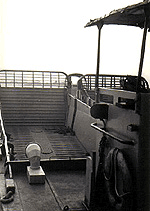The detachment used old WWII type landing craft [LCM-6’s] that were operated by the ARVN Army to ferry the teams from the Vung Tau docks to the ships. The ships didn’t stop for us so we had to board while they were moving. As we came alongside the crew of the ship would throw a line down and we would tie it to our equipment and they would haul it up.
Then a “Jacobs’s ladder”, which is a rope ladder that has an oval wooden spacer at each rung designed to hold the ladder away from the side of the ship, was lowered for us to climb. Because the LCM’s were fighting the bow wake of the ship they were bouncing up and down quite a bit and weaving in and out from the ship. This made it pretty hard to get a hold of the ladder. We learned that the safest way was to wait until the LCM was at its highest point on a wave and then grab a rung. As the boat dropped away we would find a foot hold and climb like hell before the LCM came back up and crushed our feet against the side of the ship.
